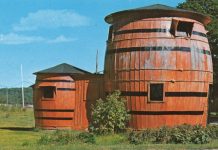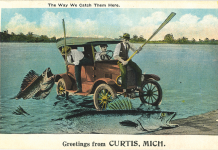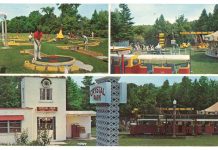
Although the first rudimentary roller skates appeared in 1743 in London, it took 120 years before the invention of the Plimpton “rocker skate,” which allowed skaters to steer just by leaning to the right or left. The first public roller-skating rink in the United States opened in 1866 in Newport, Rhode Island, but the roller-skating craze didn’t really catch on until the 20th century.
Roller-skating appeared on the big screen in 1916 with Charlie Chaplin’s film “The Rink.” Showy trick skating in the 1920s found its place in vaudeville acts. The “golden age” of roller-skating is considered to be from about 1935 through the early 1960s.

During the Great Depression, Americans turned to roller-skating for an inexpensive form of entertainment. By the late 1930s, roller-skating ranked second only to bowling as the most popular participation sport. Fred Astaire and Ginger Rogers stunned moviegoers in 1937 with their dance number on skates. By 1942, there were more than 3,000 roller-skating rinks in the country.
Some of the rinks provided live music to skate by, especially the popular sounds of the big band era. By the 1940s, the “mighty” Wurlitzer organ became a fixture in many rinks. The Wurlitzer and Hammond organs mirrored the sounds of the big band era, and many rinks offered dance lessons on wheels. Instead of just skating in endless circles, skaters could waltz, tango or foxtrot to the music provided.

Following the end of World War II, roller-skating became even more popular. Michigan joined the country in the roller-skating craze. Roller rinks appeared all over the state, from small towns in the Upper Peninsula such as Manistique, to the big cities, like Detroit and Grand Rapids, which had multiple rinks. Some rinks were converted dance pavilions, like Ramona Gardens on Reeds Lake in East Grand Rapids. Other venues, including the Big Pavilion in Saugatuck, alternated use of the building for dances, roller-skating, movies and other events. The Arena Gardens in Detroit started out as a boxing venue before adapting to roller-skating.
Clever promotions were used to draw skaters back repeatedly. There were carnival nights, barn dances, holiday parties and roller-skating queen contests. Many rinks issued their own sticker, and enthusiasts pasted their favorites on their personal roller-skate case.
 Roller-skating was promoted as wholesome recreation for young people. The Huron Pavilion in Port Sanilac switched from holding dances to roller-skating in 1938 because Mr. Barr, the owner of the pavilion, believed roller-skating is “one of the cleanest types of recreation activity for youth.” Many church groups booked their local roller rink for “proper” entertainment for their youth groups. The junior choir of the Union Memorial A.M.E. church sponsored a skating party at the Central Dock Roller Rink in Benton Harbor in 1949. Members of the Youth Fellowship of several Presbyterian churches attended a skating party in 1956 at the Bad Axe Roller Rink.
Roller-skating was promoted as wholesome recreation for young people. The Huron Pavilion in Port Sanilac switched from holding dances to roller-skating in 1938 because Mr. Barr, the owner of the pavilion, believed roller-skating is “one of the cleanest types of recreation activity for youth.” Many church groups booked their local roller rink for “proper” entertainment for their youth groups. The junior choir of the Union Memorial A.M.E. church sponsored a skating party at the Central Dock Roller Rink in Benton Harbor in 1949. Members of the Youth Fellowship of several Presbyterian churches attended a skating party in 1956 at the Bad Axe Roller Rink.
Even young children could learn to roller skate. Most rinks provided beginner’s lessons. In 1950, the Coliseum in Traverse City advertised to mothers to “leave your children with us on Saturday afternoons.” The Coliseum furnished skating and entertainment for the little tots, up to 12 years of age, for a small fee of 35 cents.
 For dating couples, the local roller rink was the place to “skate your date” as announced on the sticker from the Fieldview rink in Allegan. The J & D Roller Arena in Kalamazoo was the place “where friends meet.” It’s not surprising that many people met their future spouse on skates. Everybody but the minister was rolling down the aisle at the wedding of Muriel Bishop and Arthur Beagle in 1952 at the Arena Roller Rink in Mount Clemens. The happy couple met at the rink and later became engaged. So, they decided to be married at the rink on roller skates.
For dating couples, the local roller rink was the place to “skate your date” as announced on the sticker from the Fieldview rink in Allegan. The J & D Roller Arena in Kalamazoo was the place “where friends meet.” It’s not surprising that many people met their future spouse on skates. Everybody but the minister was rolling down the aisle at the wedding of Muriel Bishop and Arthur Beagle in 1952 at the Arena Roller Rink in Mount Clemens. The happy couple met at the rink and later became engaged. So, they decided to be married at the rink on roller skates.
Roller-skating ranged from simple fun to an outright competitive sport. The first national speed skating championship was held in Detroit in 1937 at the Arena Gardens. Skating also was a family recreation. It was good exercise for all ages and little skill was needed for basic moves. The Loon Lake Pavilion in Irons promoted roller-skating to “keep fit.” The rinks were recreational centers for all ages, with some rinks drawing hundreds of skaters daily. In later years, interest in roller-skating continued with roller disco and roller blades, but it never again achieved its cultural cachet as during the golden age of roller-skating.
BLUE Vintage Views columnists M. Christine Byron and Thomas R. Wilson reside in Grand Rapids. They are authors of the book “Vintage Views Along Scenic M-22 including Sleeping Bear Dunes.”







Facebook Comments